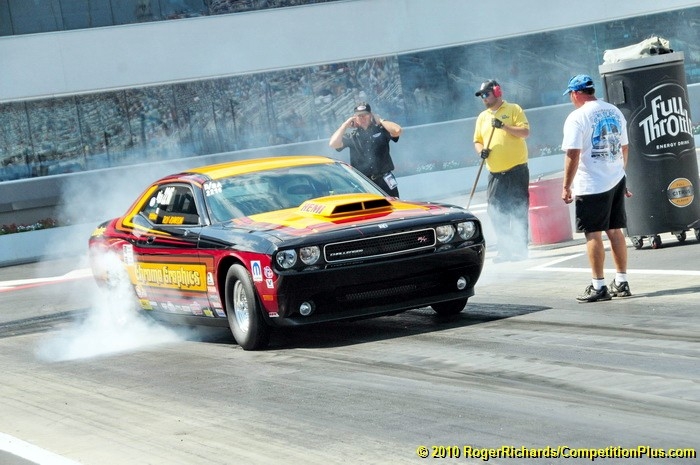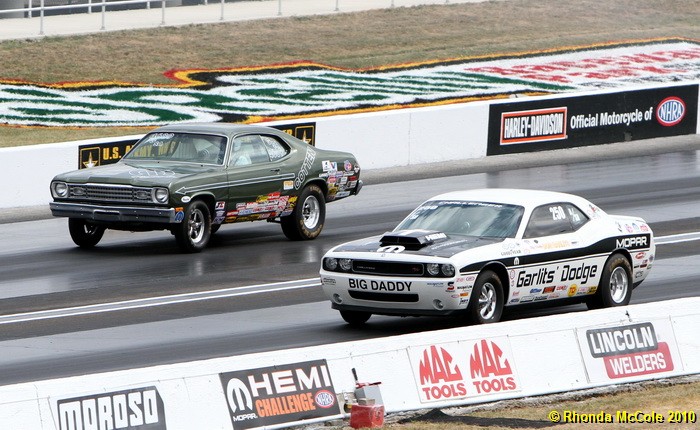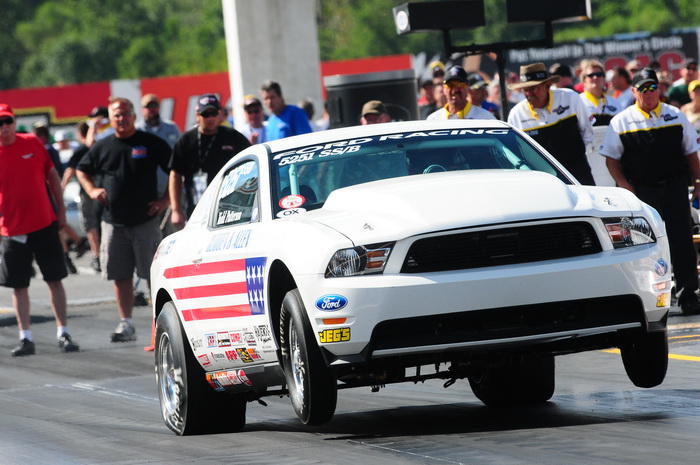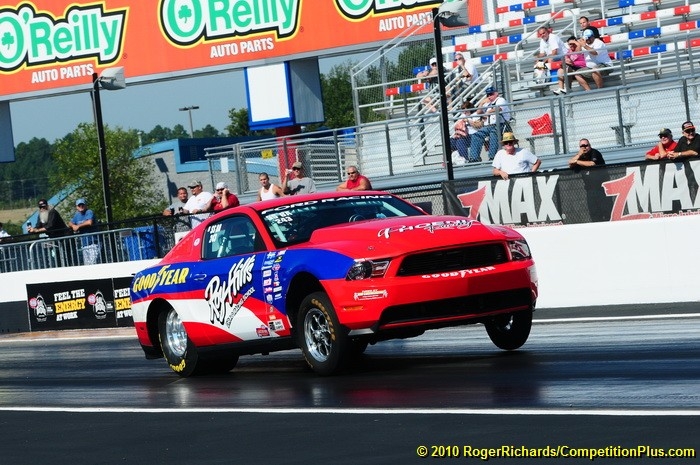NHRA MULLING CHANGES IN STOCK/SUPER STOCK
 Monitoring horsepower in all the different of types of classes is a never-ending process for NHRA officials. Presently, NHRA officials are mulling over changes that may have to take place in Stock and Super Stock.
Monitoring horsepower in all the different of types of classes is a never-ending process for NHRA officials. Presently, NHRA officials are mulling over changes that may have to take place in Stock and Super Stock.
According to NHRA rules, the NHRA Index System is used to handicap cars running in the various NHRA classes. The index for each class is based on past and potential performance. Comparing the index for the two classes involved in a handicap race will provide the handicap difference for the start of the race. Super Stock and Stock class cars can break out and therefore are given the opportunity to dial under their index.
“We’re looking at the possibility of making changes to the (Stock/Super Stock) program,” said Danny Gracia, NHRA’s National Technical Director. “When new cars are introduced manufacturers supply us with certain horsepower ratings and it will take us some time monitoring their performance to determine what the actual horsepower might be. In a perfect world, we could take all of them to a dyno and come up with a better answer. Right now, we’re using what the Ford and the Mopar representatives gave us in good faith, and we used their horsepower numbers. This is not the first time this has happened. It happened in the 90s with the Pontiacs with the 350 motors they had. They rated them at 275 horsepower and actually they ended up at 325 horsepower. We go by what the manufacturer gives us. We (NHRA) have never, as long as I have been here, just automatically added horsepower to somebody without evaluating their on track performance first.”

Monitoring horsepower in all the different of types of classes is a never-ending process for NHRA officials. Presently, NHRA officials are mulling over changes that  may have to take place in Stock and Super Stock.
may have to take place in Stock and Super Stock.
According to NHRA rules, the NHRA Index System is used to handicap cars running in the various NHRA classes. The index for each class is based on past and potential performance. Comparing the index for the two classes involved in a handicap race will provide the handicap difference for the start of the race. Super Stock and Stock class cars can break out and therefore are given the opportunity to dial under their index.
“We’re looking at the possibility of making changes to the (Stock/Super Stock) program,” said Danny Gracia, NHRA’s National Technical Director. “When new cars are introduced manufacturers supply us with certain horsepower ratings and it will take us some time monitoring their performance to determine what the actual horsepower might be. In a perfect world, we could take all of them to a dyno and come up with a better answer. Right now, we’re using what the Ford and the Mopar representatives gave us in good faith, and we used their horsepower numbers. This is not the first time this has happened. It happened in the 90s with the Pontiacs with the 350 motors they had. They rated them at 275 horsepower and actually they ended up at 325 horsepower. We go by what the manufacturer gives us. We (NHRA) have never, as long as I have been here, just automatically added horsepower to somebody without evaluating their on track performance first.”
Glen Gray, NHRA’s Vice President, Technical Operations, says the NHRA uses its Automatic Horsepower Factoring System and Stock and Super Stock cars have been hit with horsepower already.
“The Mopar Drag Pack has been hit the last three races it was at, which was in a three/four week time period and it was hit with 11 or 12 horsepower each week” said Patrick Cvengros, NHRA’s Technical Services Representative. “So, it went from 305 to 348 almost overnight you could say.”
Gray explained when the NHRA adds horsepower it actually results in weight being added to the car.
“Essentially it can move those cars to different classes,” Gracia said. “The 2009 Drag Pack can no longer run in D. The 2010 Drag Pack has a different shipping weight due to Chrysler not being able to get the lightweight body component to still run in D.”
Cvengros said the NHRA is being as proactive as possible when it comes to getting the horsepower correct for Stock and Super Stock. Gray said the NHRA is considering making changes to its Automatic Horsepower Factoring System.
Gray said the NHRA is considering making changes to its Automatic Horsepower Factoring System.
“We’re looking at the entire process and considering if we need to apply more horsepower to cars that go further under the index than in the past,” Gray said. “We were limited before in how much horsepower we could add for a given trigger run or runs. If we make a change it would be effective Jan. 1, (2011) and the drivers would be notified well ahead of time of the changes.”
Cvengros explained how the NHRA’s Automatic Horsepower Factoring System was utilized in the most recent horsepower increases.
“If you went 1.25 seconds or quicker under the index, how our (NHRA’s) system was written, all we could do was give you 3.25 percent more horsepower,” Cvengros said. “They’re changing that to have a bigger graduation of numbers or more options to where if you run as quick as some of them (Stock and Super Stock drivers) did at Indy, you may get 10 or 15 percent more horsepower.”
The AHFS is used to review and evaluate runs in Stock and Super Stock for possible horsepower adjustments.
“The Automatic Horsepower Factoring System was actually originally developed by some of the racers because they wanted to take the human element out of it,” Gracia said. “We used to take a column of all the classes and we would take the most predominate car out the equation and see what the averages were. A lot of the racers didn’t like that. They wanted to have an automatic system. This (the AHFS) was drawn up by a lot of racers and we tweaked it a little bit and this is what they wanted.”
According to NHRA policy, the AHFS review is conducted twice per racing season. The two reviews are compiled individually so the data is not cumulative. Runs included in the AHFS database are limited to final qualifying runs (Q data) and all elimination runs (E data) at NHRA national events only. (At events where class eliminations are run, all runs are included in the AHFS database. Only the first round of class is part of qualifying and therefore is part of the "Q" database.) The "Q" data and "E" data files are the official data gathered by the NHRA timing system and processed through the NHRA Information Technology department. NHRA "Q" data and "E" data are the only data files used for the AHFS.
The first review period includes data from national events 1 through 11 and the second period includes runs from events 12 through 23.
Gray said having a bigger graduation of numbers for the Stock and Super Stock is a hot topic right now.
“We’re looking at a system like that for 2011 and we’re also looking at other issues as well,” Gray said. “What Pat (Cvengros) is saying is that we (NHRA) would create more intervals. At this interval, you would get this percentage (of horsepower) and at another interval you would get this percentage (of horsepower). Current we are looking at possibly adding 5 more intervals on the current sliding scale. Like Pat said, (the way it is now), no matter how fast you went under .125 seconds you got hit with the same percent of horsepower increase. I think we all think at this point that this would do a really good job of resolving issues with cars that were running way under the index. It would allow for more resolution and range in a sliding scale. The more you go under, the more you get hit, where as now, there is more of a limit.”
The NHRA does have a sliding scale now in regards to adding horsepower, but the scale only has three numbers – 1.25 percent, 2.25 percent, and 3.25 percent. The sanctioning body also has a sliding scale for reducing horsepower. NHRA can take off 1.25 or 2.25 percent of horsepower, depending how far under the index a car is.
“What I’m trying to do is to expand that scale to broader range so that when we have these combinations that slip through the cracks and come out and run those kind of numbers like they did at Indy (Sept. 1-6), we (NHRA) are not going to be limited to only be able to give them 3.25 percent,” Cvengros said. “We will give them maybe 10 percent or 12 percent, depending on how the scale breaks down and depending on how our (the NHRA) system was worded and what we told the racers we were going to do.”
Gracia said Stock and Super Stock modifications are something the NHRA has been looking at closely throughout the 2009 and 2010 season because of evolving technology with the cars.
“Over the last two years, we have seen more new technology from the manufacturers than we have in the previous ten years,” Gracia said. This has created a need to at making changes to our current horsepower factoring system. It triggered a different move by us and that sliding scale is going to be expanded a little more. We knew going into Indy all those cars were going to show what they could run because there was so many of them. We get opinions from drivers and team owners all the time (about the Automatic Horsepower Factoring System), but nobody can come up with the right solution. I’ve been doing this for 27 years and it has always been the same way how we do horsepower and indexes. Everybody has an opinion, but at the end of the day, it is no better than we have got.”
Gracia realizes that if the NHRA does implement changes to Stock and Super Stock the sanctioning body’s decisions are not going to get rave reviews across the board.
Gray acknowledged change for Stock and Super Stock is being explored right now, the NHRA isn’t going to wait for the offseason. The final national event of the NHRA season is the 46th annual Automobile Club of Southern California Finals Nov. 11-14 in Pomona, Calif.
“At Reading, Pa., we are going to meet with some of the other people on the (Stock and Super Stock) committee,” Gracia said. “We’re going to brainstorm some of this and try to figure out what direction we will go with this, what makes more sense. The other thing that is very important that folks out there need to understand is not one person in this department can make that decision of what horsepower is going to be used. It has to go through the NHRA Stock and Super Stock committee.”
The Stock and Super Stock committee is made up of Bob Lang, Bob Blackwell, Bruce Bachelder, Dave Mohn and Cvengros. Bill Holt was on the Stock and Super Stock committee, but he is no longer on the committee because he just recently retired.
“We try to keep six members on each of the various rules committees we have and it requires a minimum two-thirds vote for anything to pass,” Gray said. “That means four out of the six have to vote the same way for anything to pass. We will not add a sixth person back to the committee until after the first of year. To arrive at a true two-thirds or more vote to make changes to Stock and Super Stock (for 2011) we will have to have four out of the five committee members vote in favor of a change.”
The 26th annual Toyo Tires NHRA Nationals in Reading is the next national event and is slated for Oct. 7-10.
“The only way we would make any change this year (to Stock and Super Stock) is if things kept happening like it has been happening,” Cvengros said. “At Indy, they ran 1.25 seconds or better under the index and at Dallas they did. So automatically by Tuesday morning they had 3.25 percent more horsepower than what they had when they started those races. By the looks of it, they will probably get more horsepower after next weekend when we have our Reading event. Nothing will change from how we have been doing it all year long and last year, until 2011 when I will have a broader range of numbers to choose from depending on how far under the index they run.”
{source}
<div style="float:left; padding:5px;">
<script type="text/javascript"> sr_adspace_id = 2000000613807;
sr_adspace_id = 2000000613807; sr_adspace_width = 300;
sr_adspace_width = 300; sr_adspace_height = 250;
sr_adspace_height = 250; sr_ad_new_window = true;
sr_ad_new_window = true; sr_adspace_type = "graphic";
sr_adspace_type = "graphic";
</script>
<script type="text/javascript" src="http://ad.afy11.net/srad.js?azId=2000000613807">
</script></div>
<div style="padding:5px;"><script type="text/javascript">
google_ad_client = "pub-8044869477733334";
/* 300x250, created 4/3/09 */
google_ad_slot = "2028912167";
google_ad_width = 300;
google_ad_height = 250;
</script>
<script src="http://pagead2.googlesyndication.com/pagead/show_ads.js" type="text/javascript"></script>
</div>{/source}





































